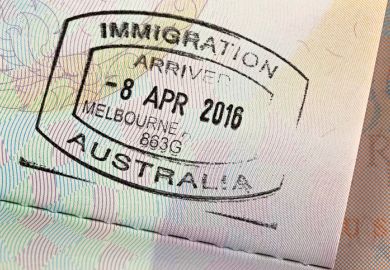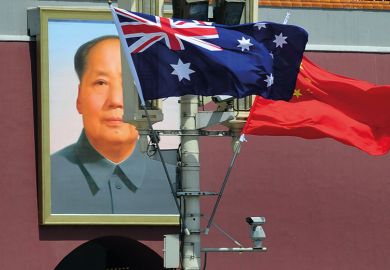Chinese students wanting to undertake PhD studies in Australia last year were three times more likely to have their visa applications rejected than compatriots targeting undergraduate or master’s courses, according to a new report obtained by Times Higher Education.
The restricted report from Australia’s trade department suggests that about 15 per cent of Chinese postgraduate research applicants were refused visas during the last financial year, compared with 5 per cent of those seeking higher education visas.
This contrasts with figures for other nationalities. On average, about 2.6 per cent of postgraduate research visa applications are rejected – compared with 5.4 per cent for would-be master’s and bachelor’s students – reflecting a perception that doctoral candidates are more committed to their learning and less likely to breach visa conditions.
The Department of Home Affairs contradicted the Austrade figures, saying its own statistics suggested that about 99 per cent of Chinese PhD applicants were granted visas last year.
The Austrade report claims to be based on a Home Affairs dataset. A caveat says the information in the report “does not exactly match” published Home Affairs figures because of “regularly updated data from global operations”.
Austrade declined to comment on the figures, referring questions to Home Affairs.
If correct, the Austrade figures add weight to claims that authorities have acted to impede Chinese PhD students – potentially over concerns that their research may be against Australia’s national interests.
In March, China’s Global Times newspaper criticised Australia for its delays in processing of doctoral students’ visas. It reported that about 100 candidates with postgraduate enrolment offers from Australian universities had been awaiting visas for “an abnormally long period”.
“There is speculation that the visa trouble is related to recent tensions in Sino-Australian relations,” the article said. “There are also claims that Chinese spies have penetrated Australian communities.”
Australian officials downplayed the report, saying only a few visa applicants had experienced delays. Home Affairs statistics corroborated this, showing that Chinese applicants faced a median wait of nine days compared with an average of 12 days across all nationalities.
However, these statistics did not discriminate between different visa classes, unlike the figures in the Austrade report.
The report is available to subscribers to Austrade’s “Market Information Package” service, which provides analyses on international education opportunities. Journalists are ineligible to subscribe, along with consultants and education agents.
Visa hurdles are among the factors thought to jeopardise student flows from China, which is easily Australia’s biggest source market. Chinese tuition fees account for up to one-fifth of total revenue at some Australian universities.
Nick Lyall, a risk analyst with Canberra-based consultancy Foreign Brief, said would-be students applying from China had experienced problems having their visas approved.
“They’d get them eventually but the process would be delayed to such an extent that it became untenable to keep considering Australia, and they were forced to look at other options," he added.
The Austrade report breaks Chinese visa applications into source provinces and cities to give subscribers insights into “developing student hubs”. Beijing, Shanghai and Guangzhou have been the biggest source cities over the past four years, with applicant numbers growing steadily, but flows from other cities have been inconsistent.
Register to continue
Why register?
- Registration is free and only takes a moment
- Once registered, you can read 3 articles a month
- Sign up for our newsletter
Subscribe
Or subscribe for unlimited access to:
- Unlimited access to news, views, insights & reviews
- Digital editions
- Digital access to THE’s university and college rankings analysis
Already registered or a current subscriber?








